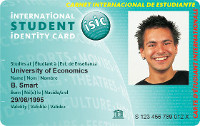 Studying in a different country is an exciting and realistic choice for both high school and university students. The experience gained can both be fun as well as highly rewarding later in opening up new and different career opportunities. The unique experience gained by studying overseas is one that will stay with the student for the rest of their life. In addition to learning about and living in a different culture, students gain many other skills including independence, time management, organization, social skills, self-confidence, financial management, and many more.
Studying in a different country is an exciting and realistic choice for both high school and university students. The experience gained can both be fun as well as highly rewarding later in opening up new and different career opportunities. The unique experience gained by studying overseas is one that will stay with the student for the rest of their life. In addition to learning about and living in a different culture, students gain many other skills including independence, time management, organization, social skills, self-confidence, financial management, and many more.
When planning to study overseas there are many thing to consider. While high school and university students have different things to consider and prepare for (see the separate sections below), there are many basic issues that all students planning to move overseas for the first time need to be aware of and plan for. Moving overseas is a huge endeavor for anyone regardless of age. Preparing for an International move at the same time as planning for school attendance in a foreign land is an even bigger challenge.
This guide is an attempt to provide an introduction to many of the issues common to most students wanting to study abroad. It is impossible to cover all possible things that may come up in a single document but hopefully this guide combined with the links at the end can provide a good start to the process. If additional assistance is needed Teachers Network works with many consultants with extensive experience in these areas and we will be happy to assist wherever needed.
Table of Contents
- Location and Size
- Housing
- Weather
- Safety
- Cultural Diversity
- Other School Types (Single-Sex, Military, Religious, etc.)
Now That I Have Been Accepted, What is Next?
- Passports
- Student Visa Application
- International Student Identification Card
- Medical Insurance
- Financial Planning
- Travel Arrangements
- What to Pack?
- Communications Abroad
What Happens When I Get There?
Educational and Cultural Risks and Problems
- English as a Second Language
- Critical Thinking / Problem Solving Skills
- Adjustment to Academic and Social Life
Where Should I Study Abroad?
Many things go into choosing an appropriate school to attend. University students are typically (or should be) focused on, in no particular order, the area of study, how well the school prepares students for the work world, and ranking in their chosen field of study. Picking a major focus of study is not required for high school students but the school quality and national ranking may have an effect on the quality of education and later college admissions. There are huge differences between high schools in terms of facilities and education quality. Other factors affecting the choice of school for students at all levels include school location, size, housing options, transportation needs and more. All of these need to be considered before making a final decision.
Location and Size
Is living in a big city or a small town important? What should the campus life be like? Are there famous landmarks, sights or tourist attractions nearby to visit? How about the night life and other activities available on the weekend when not in school? What about transportation? Can everywhere needed be reached using public transportation (buses, trains, etc)? Is a car needed and if so, does the student have all the necessary licenses and insurance to purchase and operate one? Is the school near an airport? How easy is it for the student to travel back home to their home country and how long will it take?
Housing
 What kind of housing arrangements are available? High school students choices are typically with a host family or in a dorm, in the case of a boarding school. University students who have lived near the school for a while may have an additional option and can get their own off-campus housing in the form of an apartment or house, either by themselves or with roommates.
What kind of housing arrangements are available? High school students choices are typically with a host family or in a dorm, in the case of a boarding school. University students who have lived near the school for a while may have an additional option and can get their own off-campus housing in the form of an apartment or house, either by themselves or with roommates.
Dorm living has an advantage that the student will be living with and interacting with many other students who are are going through many of the same adjustments. Dorm rooms are usually furnished with a bed and desk and provide a basic living environment. All students need to move in are clothes, books, and other personal effects. Other than the books, which are either provided by the school or to be purchased once the student arrives, the rest can fit in a suitcase or two. Dorm living usually does not have any curfew (university level) and requires the student to be much more independent. Food is usually included with dorm living.
Staying with a host family is an option normally only available to high school students and not at the university level. Living with a host family forces students to speak the local language most of the time. Host families can be very helpful in learning about the local community and culture first-hand. When problems are encountered the host family can be of great help. Disadvantages (perhaps advantages depending on your perspective) are that there are almost always strict curfews and perhaps a bit less privacy than in a dorm. Food is also usually included in this type of arrangement.
Established university students sometimes get off-campus apartments or houses by themselves or with a group of roommates. These housing options can come either furnished or unfurnished. Unfurnished accommodation represents additional upfront costs that must be budgeted for (as well as the time and effort to purchase everything needed). Independent living provides much more freedom and is often the most comfortable living arrangement. With the added freedom comes additional responsibilities for managing time and money. Food is not included making it the responsibility of the student to purchase food and prepare meals themselves. Maintenance of the housing is also fully the responsibility of the student so all cleaning and washing now falls on the student directly.
Weather
Is the climate important or can the student happily live in almost any environment? Is experiencing the four seasons or 12-months of sun and dry weather important? What kind of activities are important to do while not studying? Skiing and surfing for example normally require very different environments. If extracurricular activities are dependent on a certain type of climate don’t forget to consider this, as life overseas is not ONLY about studying.
Safety
 Every school has different issues related to safety. Is it located near a potentially violent area of a large city? Is it in a small town with few people? There are risks everywhere and they differ based on location, culture, and other factors. This is true of a student’s home town as well, but we tend to understand where we have grown up better. Try to get as much information as you can about the prospective school environment to determine if special precautions need to be considered for safety.
Every school has different issues related to safety. Is it located near a potentially violent area of a large city? Is it in a small town with few people? There are risks everywhere and they differ based on location, culture, and other factors. This is true of a student’s home town as well, but we tend to understand where we have grown up better. Try to get as much information as you can about the prospective school environment to determine if special precautions need to be considered for safety.
Regardless of location students should never forget that they are in a foreign country and need to be especially cautious until they fully understand their new environment. Care should be exercised with new people they meet. Home and school addresses and important contact phone numbers should be put in their phone and written down in their wallet. Behaviour should be reserved while trying not to do too many dumb things (like inappropriate things to impress peers). This includes alcohol consumption. In general staying under the radar (being inconspicuous) is a good rule of thumb. Integrating into their new society rather than always doing things exactly as back home is desirable. Find out where and who to go to in case there are problems. When in public most police are there to help.
Cultural Diversity
 Does the school have a large percentage of students from around the world or only a few? Will the student be the only one from your country attending the school or will there be local friends there? There are pros and cons to both types of environments. Schools without many International students may not understand the special needs of foreign students who are still struggling with language and cultural issues. This forces students to adapt and come up to speed much quicker as they are a bit less forgiving. On the other hand schools with large International student populations and/or with several friends from your home country can create other problems. Often in these situations student tend to group themselves into ethnic communities and do not adjust and integrate as well into the host culture/society. This not only makes it more difficult for the foreign student to fully fit into the local culture but often also can result in problems in the classroom.
Does the school have a large percentage of students from around the world or only a few? Will the student be the only one from your country attending the school or will there be local friends there? There are pros and cons to both types of environments. Schools without many International students may not understand the special needs of foreign students who are still struggling with language and cultural issues. This forces students to adapt and come up to speed much quicker as they are a bit less forgiving. On the other hand schools with large International student populations and/or with several friends from your home country can create other problems. Often in these situations student tend to group themselves into ethnic communities and do not adjust and integrate as well into the host culture/society. This not only makes it more difficult for the foreign student to fully fit into the local culture but often also can result in problems in the classroom.
The best solution seems to be a school with a reasonable sized International student population and programs in place to assist foreign students to get properly acclimated and integrated. It is important to note that schools cannot solve this problem alone – it requires a lot of discipline and work on the part of the student to make the effort to fit in and be an active member of the local community.
Other School Types (Single-Sex, Military, Religious, etc.)
There are many types of schools including private (independent) and public (funded by the local or state governments). Some are single-sex and accept only male or female students (but not both). Some are associated with a particular religion where it is required that students take classes in that particular religion. Other schools might be connected with the local military and provide military training in addition to academics.
Most schools (both private and public) are co-ed (accept both male and female students), are non-religious, and have no military affiliation. This does not make the other school types bad though. Depending upon the student’s interests, they may find one of these more specialized schools more to their liking. Many more specialized schools tend to be very strong in academics so if their strengths align with the student’s academic interests they should be considered.
English as a Second Language
Students planning to attend school in an English speaking country where English is not their native language will need to prove their level of proficiency. This is to show that they will be able to follow classes without any comprehension problems. English is also used as a language of instruction in a number of other countries around the world, particularly for graduate programs and business degrees. English-taught courses will be advertised on the university’s website.
English Proficiency Tests
Common tests accepted as proof of English language proficiency are the TOEFL and IELTS. Before taking a language test be sure to confirm which test results are accepted by your chosen school or schools. Also make sure you understand the test score requirements for your school and field of study.
High School Planning
 Note: Most of the information in this section is applicable to students wishing to study in North America (Canada or the United States). As we collect additional information about other destinations, in particular the United Kingdom, Australia, and New Zealand, this section will be updated.
Note: Most of the information in this section is applicable to students wishing to study in North America (Canada or the United States). As we collect additional information about other destinations, in particular the United Kingdom, Australia, and New Zealand, this section will be updated.
A lot has been written above about the non-academic considerations to take into account when choosing a new school. Students going abroad to school will usually be studying and interacting with a diverse group of peers. Other students and school staff usually come from a wide range of cultural, ethnic, and financial backgrounds. This can require an adjustment for some who are not used to such diverse environments.
Another difference between schools in China and many other parts of the world is the increased focus on extracurricular activities. These can be anything from active involvement in one of the school sports teams to specialized interests such as music, drama, the school newspaper, community service and hundreds of other areas of interest. The people at PrepScholar have put together an extensive list on their Complete List of Extracurricular Activities: 100’s of Examples page. Not all of these will be available at every school but the list can give you an idea of what might be possible. It is important to note that colleges and universities look at extracurricular activities in addition to academic qualifications in their admissions process so active involvement in one or more outside activities is highly encouraged. In addition most activities can also be a lot of fun and be a great break from the routine of study while making new friends!
The people who run the SSAT test have put together a lot of very good information on their website that can help students prepare. One particularly good video (about an hour in length) can be found on the Choosing A School page. The video is titled Applying to Boarding Schools – Advice on Navigating the Application Process and should be a must see for all students and parents, regardless if going to a boarding (private) school or not.
Timeline
 Planning for and getting everything ready before heading off to a school in a foreign land is both time consuming and a lot of work. A good rule of thumb is to start the process 18 months (a year and a half) ahead of when you want to start school. Most students start at their new school at the beginning of high school (grade 9). It is possible to start at other times but it might not be as easy getting established since other students will have had more time at the school already.
Planning for and getting everything ready before heading off to a school in a foreign land is both time consuming and a lot of work. A good rule of thumb is to start the process 18 months (a year and a half) ahead of when you want to start school. Most students start at their new school at the beginning of high school (grade 9). It is possible to start at other times but it might not be as easy getting established since other students will have had more time at the school already.
Some of the things that will need to be completed include the following:
- Standardized Tests: Most schools in the United States and Canada will require taking the SSAT test. If the student is coming from a non-English speaking country then it may also be necessary to take the TOEFL test. Check with the schools in which you plan to apply for their specific requirements.
- Research the Schools: This is right up there with taking the required standardized tests and should be done as early as possible. Try to find several schools that meet your requirements.
- The Application Process: This is when you reach out to your list of several desirable schools to get more information and then apply for admissions.
- School Visit / Interview: After you have a good idea of where you might want to go and have had some communication with the school you may want to actually visit them personally. If visiting in person the application interview can happen then, otherwise can be done remotely via Skype or other means.
Research the Schools
 When trying to decide what schools to apply to, do as much research into each school as you can. Don’t just rely on school rankings or the information presented in the school website (but these should always be included). In addition to the issues documented above in this article about (location, weather, etc), some additional things you might try to find out include:
When trying to decide what schools to apply to, do as much research into each school as you can. Don’t just rely on school rankings or the information presented in the school website (but these should always be included). In addition to the issues documented above in this article about (location, weather, etc), some additional things you might try to find out include:
- School Mission: Does the school have an area or areas of specialization? What is the focus of the teachers and their main strengths?
- Course Catalog: What kind of classes are offered and at what level? Do they have an active AP program and if so what subjects are taught?
- Extracurricular Activities: What kind of activities are available outside the standard classroom time? Are there any extra costs with them? How will they help in preparing for college or university application later?
- English as a Second Language: Is this the first time the student has had to attend a school teaching in English? How comfortable are they communicating with native English speakers? If language is a concern then it is best to consider schools who can also offer additional language assistance to foreign students.
- Costs: What are the costs for attending the school? This should include everything including tuition, room and board, books, and anything else that is required to be paid for.
A Note on School Ratings and Reviews: There are many organizations who provide ratings and reviews on high schools. Several of these lists are included below in the reference section of this document. Many in the high school education business in North America however do not have high opinions of these rankings, with some even claiming they do more harm than good. Our recommendation is to check with as many as you can (there is not a high correlation between them) but also consider these rankings as only one piece of the entire puzzle. Do your own research and talk to the schools whenever possible to try to get the rest of the information.
Try to come up with at least ten schools of interest. What are their admissions requirements and can you meet them? Try to come up with a range of schools to apply for. Having a choice of several is a lot better than pinning all your hopes on a single school which may or may not grant admissions.
The Application Process
 Before applying to schools be sure to have taken all the required standardized tests. Most schools in North America will require students to take the SSAT test. The test needs to be taken in the same school year as the application is submitted. If the student is coming from a country where English is not the native language, many schools may also require the student to take the TOEFL test. Preparing for both of these tests takes a lot of time. In addition time to take the tests needs to be scheduled followed by a waiting period to receive the scores. Many students also prefer to allocate enough time to take the tests a second time in case the first set of scores was not what they were expecting.
Before applying to schools be sure to have taken all the required standardized tests. Most schools in North America will require students to take the SSAT test. The test needs to be taken in the same school year as the application is submitted. If the student is coming from a country where English is not the native language, many schools may also require the student to take the TOEFL test. Preparing for both of these tests takes a lot of time. In addition time to take the tests needs to be scheduled followed by a waiting period to receive the scores. Many students also prefer to allocate enough time to take the tests a second time in case the first set of scores was not what they were expecting.
After taking the necessary standardized tests and coming up with a short list of desired schools, it is time to start contacting schools. In your initial inquiry to the school (check the school website for contact forms and/or contact email addresses) ask for their school application form, the school calendar for applicants, a list of required documents to submit, and any other documents the school normally provides prospective students. The later can include things like a school handbook with detailed descriptions of how the school operates and student responsibilities. Typical documents that most schools will require are school transcripts and letters of recommendation from past teachers.
During this period be sure to ask as many questions as you need. Schools that provide additional documents such as school handbooks often provide a lot of information you need there so be sure to read and understand what is in them. Any other unanswered questions should be sent to the attention of your contact person at the school. They are there to help and it is also in their best interest that students do well and understand everything about their new environment.
If after going through this process you feel the school might be right for you it is time to fill out and send in the application. The application form may also ask for the student to write a short essay to include together with the additional required documents (transcripts, letters of recommendation, etc). If all goes well and it looks like a good fit for both the student and the school it is time for the school visit and interview. It is always best to try to schedule a visit to the school to get a better feel for what it would be like to live and study there. Schools will work with you to arrange a time and someone to show you around. Time will be reserved to directly interview the student by school staff at this time. If physically visiting the school is not practical, usually due to the distance, the school interview can be arranged over the Internet using tools such as Skype or similar.
Financial Aid
 Some schools may be able to provide financial aid to students. Normally financial aid packages are made available only to students from the same country as the school as they are paid for through local government funds. There may be exceptions to this however so check with your school for details as they may apply to you. Another site that can provide additional information, especially to students local to the school, is the School and Student Services Financial Aid page for parents.
Some schools may be able to provide financial aid to students. Normally financial aid packages are made available only to students from the same country as the school as they are paid for through local government funds. There may be exceptions to this however so check with your school for details as they may apply to you. Another site that can provide additional information, especially to students local to the school, is the School and Student Services Financial Aid page for parents.
University Planning
 Unlike students studying at the lower levels, college and university students need to declare a major area of study. This decision greatly factors into the choice of school. Your university training is meant to prepare you for your life after school and is perhaps one of the most important decisions you will ever have to make. Take time to think it through. People trained and working in areas they genuinely enjoy are not only happier but do better in their careers.
Unlike students studying at the lower levels, college and university students need to declare a major area of study. This decision greatly factors into the choice of school. Your university training is meant to prepare you for your life after school and is perhaps one of the most important decisions you will ever have to make. Take time to think it through. People trained and working in areas they genuinely enjoy are not only happier but do better in their careers.
In addition to the purely academic considerations don’t forget to take into account the issues documented above including location, weather, culture and others as they apply to you. You will be spending the next four years (perhaps more) here so it should be a place you not only get a great education from but one which you enjoy living in.
Timeline
 Taking all the required tests, researching and applying to schools, and making travel plans all takes a lot of time. Try to start this process 18 months (a year and a half) ahead of when you want to start school. If you are coming from a non-English speaking country it will be necessary to also take either the IELTS or TOEFL tests to show you can follow classes in English.
Taking all the required tests, researching and applying to schools, and making travel plans all takes a lot of time. Try to start this process 18 months (a year and a half) ahead of when you want to start school. If you are coming from a non-English speaking country it will be necessary to also take either the IELTS or TOEFL tests to show you can follow classes in English.
Some of the things that will need to be completed include the following:
- Pick a Major: Your choice of major will largely determine which schools to apply to and your future career. Think through this decision carefully.
- Standardized Tests: Schools in the United States and Canada will require taking either the SAT or ACT tests. Other tests that can help in the admission process are the SAT Subject Tests and the AP Tests. If you are coming from a country where English is not the native language it will also be necessary to take either the TOEFL or IELTS tests. Check with the schools in which you plan to apply for their specific requirements. Generally speaking schools in the UK will prefer the IELTS and those in North America the TOEFL but some schools may accept either. There is no preference over which college entrance exam is taken as both the ACT and the SAT are accepted by all major universities in the United States.
- Research the Schools: This is right up there with taking the required standardized tests and should be done as early as possible. Try to find several schools that meet your requirements.
- The Application Process: This is when you reach out to your list of several desirable schools to get more information and then later apply for admissions.
- School Visit / Interview: After you have a good idea of where you might want to go and have had some communication with the school you may want to actually visit them personally. If visiting in person the application interview can happen then, otherwise can be done remotely via Skype or other means for many schools.
Research the Schools
 When trying to decide what schools to apply to, do as much research into each school as you can. The college rankings in general seem reasonably accurate but you should check several as they do not all rate the same way. The school website is a critical source of information that should be read in depth. In addition to the issues documented above in this article about (location, weather, etc), some additional you might try to find out includes:
When trying to decide what schools to apply to, do as much research into each school as you can. The college rankings in general seem reasonably accurate but you should check several as they do not all rate the same way. The school website is a critical source of information that should be read in depth. In addition to the issues documented above in this article about (location, weather, etc), some additional you might try to find out includes:
- School Reputation: Is the school well regarded in your major? Are they involved in research? The later may be important in later years and especially if you were to consider continuing on for graduate studies.
- Other Strengths: In addition to strengths in your major does the school have good programs in similar disciplines? Everyone tries to nail down their major going into their freshman year however it is not uncommon for students to sometimes change major. If you can do this without changing schools it is highly desirable.
- Extracurricular Activities: What kind of activities are available outside the standard classroom time? Are there any extra costs with them?
- English as a Second Language: Is this the first time the student has had to attend a school teaching in English? How comfortable are they communicating with native English speakers? If language is a concern then it is best to consider schools who can also offer additional language assistance to foreign students.
- Costs: What are the costs for attending the school? This should include everything including tuition, room and board, books, and anything else that is required to be paid for.
- Deadlines: Each school has their own deadlines for admissions applications, financial aid applications, acceptance notifications and others. Be sure you understand all applicable deadlines for each school you plan to apply to.
The Application Process
 UK Schools
UK Schools
Applicants to universities in the UK can use the Universities and College Admissions Service (UCAS). Most universities in the UK use this service and require applicants to submit their requests through it. Depending on the subject and the university that they are applying for, candidates must submit their application by the relevant submission deadline to ensure their application is given equal consideration. Deadlines include:
- 15 October: Those applying for medicine, dentistry and veterinary science courses and anyone applying to the universities of Oxford and Cambridge must submit their UCAS applications by 15 October – in the year before the student wishes to start their studies.
- 15 January: The majority of applications must be submitted by 15 January (in the calendar year that the student wishes to begin their studies).
- 24 March: Some art and design courses have a later application deadline – 24 March – to give them time to complete their portfolios.
It is possible for students to submit applications up until 30 June each year; but a late submission may not be given the same consideration as those submitted before the deadline. Applications received after 30 June are placed directly into Clearing. For more information see the UCAS website.
Non-UK Schools
Applicants to schools in the USA and Canada have in the past had to provide separate applications to each school they wanted to apply to. While this is still true for many colleges and universities, a relatively new common registration system, The Common Application is used by over 600 of the leading universities in North America with several schools in Europe now also supporting the system. Like the UCAS, this system allows students to prepare one application to be submitted to several institutions. Check with the Common Application website for a current list of Universities they work with. The Common Application greatly simplifies the application process however it is still important to check with each school to find out their specific requirements, application deadlines and application fees.
Common Requirements
Most schools will require most if not all of the following:
- Standardized College Entrance Exam Results: The scores from your SAT, ACT, SAT Subject Tests and/or AP Tests. These need to be sent directly from the testing organization to the school.
- TOEFL/IELTS Certificate: If you are not coming from an English speaking country the results of one of these tests will need to be submitted. Check with the schools you wish to apply to for which test is required and any scoring requirements (common for institutions accepting the IELTS).
- Extracurricular Activities: A list of your extracurricular activities both inside and outside of school.
- High School Transcript: A copy of your academic records from high school. Many schools require this be sent directly from the school. If your records are not in English they will need an official translation.
- Student Essay / Personal Statement: This is a short document written by the student.
- Passport: A copy of your passport identification page.
- Bank Statements: Financial records showing sufficient funds for one year.
- Parent / Legal Guardian Information: Information about your parents or legal guardian such as educational background, occupation, employer, and contact details.
Financial Aid
 Schools which rely upon government funding typically will not offer financial aid to foreign students. But this is not always the case. If you have a need for financial aid don’t assume a given school will not be able to help. Instead directly contact the school’s admissions office and let them know you are interested and inquire about any programs that might be applicable in your case. Some schools will ask on the application form if you plan to apply for financial aid. Be careful how you answer this because some schools (Stanford University is one example) will not reconsider an aid application anytime during the four year term if you answer there is no need in the initial application. When in doubt ask the school directly any questions you may have about the application as it relates to financial aid.
Schools which rely upon government funding typically will not offer financial aid to foreign students. But this is not always the case. If you have a need for financial aid don’t assume a given school will not be able to help. Instead directly contact the school’s admissions office and let them know you are interested and inquire about any programs that might be applicable in your case. Some schools will ask on the application form if you plan to apply for financial aid. Be careful how you answer this because some schools (Stanford University is one example) will not reconsider an aid application anytime during the four year term if you answer there is no need in the initial application. When in doubt ask the school directly any questions you may have about the application as it relates to financial aid.
Now That I Have Been Accepted, What is Next?
Now that you know where you want to go to school and have been accepted it is time to start planning for the actual move. Before you can leave the country you must obtain a passport and in order to enter the host country you will need a student visa. After all the travel documents are in order it is time to take care of several practical issues. You will need medical insurance in case you get sick or need emergency medical attention. Money also needs to be planned so that your basic room and board is taken care of and you know how you will pay for all your other expenses. Finally you should plan for how you will communicate while away from home. Making daily phone calls back home can get expensive very quickly. Setting up your mobile phone for overseas use together with instant messaging and electronic mail channels with your friends and family back home should be done before you leave.
Passports
Valid passports are essential for all International travel. It is not possible to enter another country without one. Every country has their own procedures, fees, and processing times for the initial visa application and renewals. The treatment of each of these is outside the scope of this document however we strongly recommend that securing a passport be one of the first tasks to complete. Most governments require a valid birth certificate for first passport applications. Depending on the local government requirements, required documents to obtain, and processing times it could take up to a year to process the initial passport application. Do not wait until the last minute to take care of this critical step or you may find yourself unable to travel.
Student Visa Application
 Obtaining a student visa for the country to study in will be required for most students. Exceptions to this rule include students from European countries wishing to study in other EU countries. All other students leaving their home country to study will need proper permission and visas from the host country.
Obtaining a student visa for the country to study in will be required for most students. Exceptions to this rule include students from European countries wishing to study in other EU countries. All other students leaving their home country to study will need proper permission and visas from the host country.
Each country has their own set of requirements and application forms for student visas. Most require a similar set of supporting documentation including some or all of the following:
- Sponsor Letter: This is a letter from the school to attend stating they are sponsoring the student. This letter can obtained only after being accepted for admissions by the school. It normally includes information such as tuition and room and board costs, proof of housing, etc. Some schools will only issue this letter after the initial fees have been paid so be sure to check with your school for their policies early in the application process.
- Personal Financial Statement: Written proof that the student has a certain amount of money in a bank account in their name which can be used to cover living expenses. This is separate from room and board costs. The government needs to know that once a student arrives they have the financial resources necessary to live.
- Tuition Payment: Proof that the student either has the means to pay tuition costs or that it has already been paid.
- Biometrics: Fingerprints – this is normally taken care of when visiting the immigration center or consulate to finish the application process.
- Passport: This needs to be provided along with the other supporting documentation to the immigration center or consulate processing the student visa application. Once approved the student visa will be inserted into the passport.
- Passport Quality Photos: Photographs to accompany the visa application. Each country has their own size and other requirements so be sure to check with the appropriate government website for the details as they apply to your application.
As a general rule of thumb be sure to send out visa applications at least two months in advance. Processing times vary by host country and application center. If in doubt check directly with the appropriate immigration center or consulate for the latest information.
International Student Identification Card
 While not a requirement for studying overseas, obtaining an International Student Identity Card can be a convenient and cost saving thing to have. The ISIC is the only internationally accepted proof of full-time student status and is endorsed by many International organizations. It is used by more than 4.5 million full-time students in 120 countries every year giving them access to tens of thousands of student services and benefits worldwide.
While not a requirement for studying overseas, obtaining an International Student Identity Card can be a convenient and cost saving thing to have. The ISIC is the only internationally accepted proof of full-time student status and is endorsed by many International organizations. It is used by more than 4.5 million full-time students in 120 countries every year giving them access to tens of thousands of student services and benefits worldwide.
The ISIC card only costs US$ 25.00. For more information, including how to order the card and available discounts please check the ISIC website.
Medical Insurance
Most schools and visa granting organizations require students to have appropriate health insurance as a condition for admissions. Insurance coverage must cover incidents that occur while the student is overseas. For specific information check with the government organization who will issue the student visa to see what their requirements. Also check with the school to find out their requirements. They will likely not be the same and it is the responsibility of the student to obtain coverage that at a minimum covers the requirements of both the government as well as the school.
 A good place to start is to check with any existing health insurance coverage you may have to see if it includes coverage in the desired country and more specifically in the region near the school. If the existing coverage meets with the government and school requirements you are set – all that is needed is documentary proof of coverage. If not then additional insurance coverage will be necessary.
A good place to start is to check with any existing health insurance coverage you may have to see if it includes coverage in the desired country and more specifically in the region near the school. If the existing coverage meets with the government and school requirements you are set – all that is needed is documentary proof of coverage. If not then additional insurance coverage will be necessary.
If you need to purchase new insurance first check with the school admissions office. Many schools work with local insurance providers and can directly offer student insurance plans or refer you to companies that can work with you directly. If you have existing coverage with a company that also operates in the country you are going to live check with them as they may be able to extend your existing coverage to include overseas locations. If you have an ISIC membership check with them to see the extent of coverage that may be included in the membership.
It is extremely important for proper insurance to be in place before the student leaves home. In some countries, such as the United States, it can be very difficult to get basic, accidental, or emergency medical services without it. Medication costs can also be extremely high without good coverage. Finally it is best if the student has some type of credit or debit card on them at all times. If emergency medical treatment is necessary proof of insurance and a credit/debit card can make life much easier.
Financial Planning
 Make sure all the student’s finances are taken care of well ahead of time. This includes any local obligations, tuition and board, travel, and basic living and school expenses. Running into financial problems away from home is a nightmare scenario to be avoided at almost all costs. Many schools will also require that all major payments (tuition, room and board) are paid in advance as well as proof that the student has the ability to pay for living expenses before they issue a sponsor letter for the student visa.
Make sure all the student’s finances are taken care of well ahead of time. This includes any local obligations, tuition and board, travel, and basic living and school expenses. Running into financial problems away from home is a nightmare scenario to be avoided at almost all costs. Many schools will also require that all major payments (tuition, room and board) are paid in advance as well as proof that the student has the ability to pay for living expenses before they issue a sponsor letter for the student visa.
The sooner the student can establish a local bank account with an ATM card the better. If not possible to do before the start of school, the student should at least have an ATM card with the home country bank which will be accepted in the host country. If in doubt about the later check with your local bank, let them know where you are travelling to make sure that their cards will be accepted there. Even if you know the cards will be accepted it is good to check with your local banks before you go as some by default have International access blocked (HSBC in Hong Kong is one example of a bank who now does this). Also check the foreign withdrawal fees – almost all banks will charge extra for foreign access and sometimes these charges can be quite high. Make sure you understand how this works before you go so there are no unpleasant surprises abroad.
While travelling it is usually a very good idea to have at least US$ 300 in currency for emergencies and basic costs such as food and other necessities needed upon arrival. The cash ideally should be in the currency of the host country but if not possible make sure it is in a currency that is easily convertible.
Travel Arrangements
 After getting the passport, selecting the school, and securing the student visa it is time to make travel arrangements. Some student visa applications may require this to be done before granting the visa so be sure to check out the visa documentation requirements carefully. The order in which the different tasks are completed vary depending on destination country so always be sure to understand all the documentation requirements clearly so obtaining all the necessary paperwork on time is well understood and nothing is left to the last minute.
After getting the passport, selecting the school, and securing the student visa it is time to make travel arrangements. Some student visa applications may require this to be done before granting the visa so be sure to check out the visa documentation requirements carefully. The order in which the different tasks are completed vary depending on destination country so always be sure to understand all the documentation requirements clearly so obtaining all the necessary paperwork on time is well understood and nothing is left to the last minute.
When it is time to make travel arrangements the actual process is usually quite simple. All you need to know is the departure city, destination city, and date of departure. Armed with a credit card and a good Internet connection (or travel agent) the rest is simple. One important thing to note though is that many airlines and/or host countries may require the traveller to have onward travel reservations before they are allowed to enter the country. Check with the airline and/or the visa processing agency for current information as it applies to you.
Generally speaking it is a good idea to book a round trip ticket (a ticket good for travel both to the host country and back home). These tickets tend to be cheaper than one separate one way tickets and present fewer problems at airline check-in counters. The problem is that unlike the departure date, the return date will likely not be known at the time the ticket is issued. There are two options here – to purchase a ticket with an open return (a return date you can set later), or to set a return date that you can later change. Be careful with this however as not all fares have return dates that can be changed. Even with fares that allow you to change the dates, some allow only one or two changes after which they charge high fees for any modifications. Some airlines charge rebooking fees for all changes. Make sure you also understand the ticket validity. This is the length of time the ticket is valid. Purchasing an open return ticket with a 90-day validity for instance will not work if you intend to stay for 9 months.
It is also critical to understand how much luggage can be checked through to your final destination. This varies widely by both country and airline. When booking the tickets you need to take into consideration the baggage weight limitations as well as excess baggage fees. Excess baggage fees are often prohibitively expensive and depending on the amount of extra luggage can easily cost more than the original ticket! If there is a lot to go with the student it is usually much cheaper to pack and ship any non-essential and bulky items ahead of time using local companies familiar with International shipping. In this case you will need a shipping address in the host country to ship to and should plan for shipping at least a month in advance unless using air freight (much more expensive).
Finally be sure you understand how you will get to the departure city airport from home as well as from the destination city airport to the new school housing. If there are International airports in both cities this is usually pretty simple. If travelling to a small city not close to an International airport it may involve transfer to small airlines (which have their own baggage constraints) or land transportation (bus, train, etc). The school admissions office can probably offer some assistance here as well as the host family, for students staying with a family.
What to Pack?
 There is no one size fits all answer to this question. A lot depends on other factors such as needs on the school side, anticipated extracurricular activities, and personal needs. Generally speaking it is best to travel as light as possible. This is not only cheaper but also makes it much easier to move and get around. Remember most of the journey will not be sitting back on the airplane but getting to and from the various airports. The less there is the drag around the easier and more practical it will be. A good rule of thumb is to try to fit everything critical into no more than two medium sized suitcases. If there is still more to send, ship it ahead of time through a local shipping company. This will almost always be far cheaper than excess baggage rates and won’t kill the student trying to drag all of this around on their own. It does take some advance planning however so that the non-essential stuff can be packed and sent out far enough in advance to arrive when needed.
There is no one size fits all answer to this question. A lot depends on other factors such as needs on the school side, anticipated extracurricular activities, and personal needs. Generally speaking it is best to travel as light as possible. This is not only cheaper but also makes it much easier to move and get around. Remember most of the journey will not be sitting back on the airplane but getting to and from the various airports. The less there is the drag around the easier and more practical it will be. A good rule of thumb is to try to fit everything critical into no more than two medium sized suitcases. If there is still more to send, ship it ahead of time through a local shipping company. This will almost always be far cheaper than excess baggage rates and won’t kill the student trying to drag all of this around on their own. It does take some advance planning however so that the non-essential stuff can be packed and sent out far enough in advance to arrive when needed.
So what are the essential things to pack in your two suitcases? We’ve reproduced a sample packing list (originally published by the Study Abroad people in their Study Abroad Student Guide). This is a good guide to download (registration required) regardless of where you are going. It was written with American students leaving the United States in mind but many of the issues are the same regardless of destination.
Communications Abroad
 Being able to easily and cheaply communicate is important no matter where you are. For students far away from home it is critical. If at all possible try to get communications issues setup and tested before leaving home. If the student needs to communicate with parents back home (who doesn’t?) make sure that the parents communications devices (cell phones, instant messaging accounts and applications, and email) are all setup and they know how to use them properly. Trying to describe how to download, install, and configure applications to non-technical people back home can be both expensive and very frustrating. Do everyone a favor and get this taken care of before the first trip.
Being able to easily and cheaply communicate is important no matter where you are. For students far away from home it is critical. If at all possible try to get communications issues setup and tested before leaving home. If the student needs to communicate with parents back home (who doesn’t?) make sure that the parents communications devices (cell phones, instant messaging accounts and applications, and email) are all setup and they know how to use them properly. Trying to describe how to download, install, and configure applications to non-technical people back home can be both expensive and very frustrating. Do everyone a favor and get this taken care of before the first trip.
Cell Phones
There are several cell phone standards and networks used around the world. Cell phones are designed and built to work with specific networks. Taking a cellphone designed for one network and trying to use it on a different network type usually will not work. A detailed discussion of the different cellular technologies is outside the scope of this document. To determine if you can take your phone with you first check the technical specification for your phone. It will list what network types it can operate on. Look for things like GSM, LTE, CDMA and stuff like that. Then you will need to find out if any of the cellular providers with service in the area of your school support one of these standards. Most support GSM however if you need a reasonable data plan you will want more than the old-fashioned GSM as your only way to communicate (GSM was great for SMS and voice but not much else). Make sure you have an “unlocked” phone. Some phones, especially those sold outside of Asia and by some cellular providers in Asia, are locked to a single providers network and cannot work on any other network. If you own a locked phone your only choices are to find a way to unlock the phone (risks involved if not done properly) or to purchase a new phone. If you need to purchase a new phone try to get one that is unlocked so that you can use it on different networks as you travel (with local SIMs). If travelling to the USA it is usually easier and cheaper to purchase unlocked phones in places like Hong Kong. Just be sure to match the phone network support with the network types you will need to use in your host country.
Instant Messaging
It seems that almost everyone these days communicates using at least one form of instant messaging (IM). Instant messaging provides the ability to cheaply and quickly send short messages to other people (or groups of people) using a wide range of devices. Popular IM clients (the programs or applications people use) are common on the web (through your favorite browser) and as downloadable applications for most cell phones and tablets. The most popular IM clients at the time of this writing are WeChat, WhatsApp, Skype, and Facebook Messenger. Use of any of these requires an active Internet connection – either on a desktop machine (wired or wi-fi) or cellphone/tablet (cellular data plan and/or wi-fi).
 If you need to communicate with people in China you will almost always want to use WeChat (Weixin) as it is by far the most popular instant messaging application there. Outside of China however it is not widely used (but acceptance is growing). For non-China use the equivalent to WeChat is WhatsApp which has an even larger International user base than Wechat’s total users (both are huge). Skype has been around for a long time and is firmly established especially in the business community. Facebook Messenger is tightly integrated with the whole Facebook experience and can easily be used over the web or through dedicated applications (Android and iOS). All of these allow for simple text messaging as well as voice and video calling. Also be aware of possible access issues. At the time of this writing Facebook Messenger access in China usually is not possible so if you need to contact the parents back in Shanghai, you’ll want to rely on one of the other solutions. When communicating with your new buddies at school however Facebook Messenger and WhatsApp are likely going to be your first choices.
If you need to communicate with people in China you will almost always want to use WeChat (Weixin) as it is by far the most popular instant messaging application there. Outside of China however it is not widely used (but acceptance is growing). For non-China use the equivalent to WeChat is WhatsApp which has an even larger International user base than Wechat’s total users (both are huge). Skype has been around for a long time and is firmly established especially in the business community. Facebook Messenger is tightly integrated with the whole Facebook experience and can easily be used over the web or through dedicated applications (Android and iOS). All of these allow for simple text messaging as well as voice and video calling. Also be aware of possible access issues. At the time of this writing Facebook Messenger access in China usually is not possible so if you need to contact the parents back in Shanghai, you’ll want to rely on one of the other solutions. When communicating with your new buddies at school however Facebook Messenger and WhatsApp are likely going to be your first choices.
Electronic Mail
Instant messaging is great for quick and interactive discussions across great distances but it is limited to short messages. After all who wants to type a book on a mobile phone? For more detailed messaging, or for when documents, images, or other material needs to be sent, electronic mail is a better choice. Like the IM choices above students may end up with more than one email account. For example many in China use free email accounts from providers such as qq.com (TenCent), 163.com (NetEase), Sina and others. These are easy to access in China but may not be as practical or desirable to use outside of China. Common free email free providers outside of China include gmail.com (Google), outlook.com and live.com (Microsoft) and others. Like the Chinese providers, some of these may or may not be practical to use inside of China (gmail, likely the largest free provider in the world, has been blocked for a long time in China at the time of this writing). The student is also likely to be assigned a school email account when they arrive so the school side may be solved quickly and easily. Be sure though that family and friends back home have their own email accounts they can access and know how to do it before leaving for school. Trying to train people remotely is very difficult even for people whose business is electronic mail. Get this done before you leave and everyone will be much happier.
What Happens When I Get There?
After many months of planning and anticipation you finally get on the plane and leave home for your new school? What can you expect once you get there? This may be the first time on your own for an extended period of time so some feelings of loneliness and home sickness are common. Food and transportation will probably be very different as well. Not to worry though – with proper planning and preparation all of these can be dealt with easily.
Dealing With Home Sickness
 Picking up and moving home across town is often a traumatic experience and one that is amplified as the distance increases. Add to this that most students have little experience in moves of the magnitude, it is often the first time they have to fend for themselves, and they have to execute the foreign side of the move by themselves without the local support network of their family, and it is no surprise that home sickness often creeps in. At the same time though this is likely to be one of the most exciting and memorable times of their lives.
Picking up and moving home across town is often a traumatic experience and one that is amplified as the distance increases. Add to this that most students have little experience in moves of the magnitude, it is often the first time they have to fend for themselves, and they have to execute the foreign side of the move by themselves without the local support network of their family, and it is no surprise that home sickness often creeps in. At the same time though this is likely to be one of the most exciting and memorable times of their lives.
Home sickness is a normal part of moving to a new culture away from home for the first time. It does not have to be something that negatively affects student’s life abroad though. A few things that can help include:
- Stay Busy: Don’t give your mind time to dwell on your life back home. Stay busy doing and planning your new activities. Keep up with all your studies at all times. Keep in mind that people most often remember only the good things in their past and don’t think as much about the bad. Stay positive and look at all the good things in your new home.
- Look to the Future: The first move to a new culture is one of the most exciting times in most peoples lives. What new things are there to see or experience in the new home? What activities are there in the new home that would be impossible to see and do back home? Are there new foods you have not tried yet? What about other cities and countries that are close by? Think of all the new things you can learn and experience and tell your family about!
- Talk to Other Students: Chances are there will be other students who are far away from home for the first time also. Talk to them as they have likely had or are having the same experience, and may be able to provide some good advice. It’s also a great way to find more new friends.
- Stay In Touch:The modern Internet has effectively made the world a much smaller place. Email, Instant Messaging, Social Networking (Facebook, Instagram, etc) and other new tools continue to shrink our world and let us all communicate quickly and cheaply in ways never before imagined. Making use of several of these tools will help keep the student in close contact with family and friends back home greatly reducing any grief of being so far away.
Eating
It is impossible to fully embrace and understand a foreign culture without sampling the local cuisine. Don’t get caught in the trap of only being able to eat food like you grew up with back home. Not only will eating like a local be critical in your fitting into your new society you will probably find many new foods you really enjoy. Exploring and enjoying new foods is a large part of the excitement of getting to know a new culture.
Transportation
Get to know how you will get around in your new country. Chances are the transportation choices, costs and other aspects of getting around are not the same as back home. While most of the large cities in Asia have large and extensive subway systems the same cannot be said for all other locations. Smaller cities regardless of country seldom have the same transportation infrastructure of the larger cities. For these locations buses, taxis, bicycles and private transportation (motorcycle or cars) are your choices. Try to understand the layout of your city and know where you will be staying and most of the important places you will need to go. Tools such as Google Maps can be very helpful as bus routes are often presented with the maps. Street views are also often available letting you get a better idea what the area is like before you even leave home. Finally research the costs associated with whatever transportation choices you make. Bicycles are of course the cheapest form of travel but limited in distance and can be difficult during bad weather (rain, snow, etc).
Middlemen and Fraud

Preparing and assisting students who want to study abroad has become big business both in China and the United States (among other destinations). Students in China’s test-centric education system focus their high school time almost exclusively on the gao kao test. This exam is the sole determining factor for college placement in China’s universities. Have a bad day, or not be at the top of the national class and the student’s chances of going to a good school are severely diminished. This combined with limited space in China’s top schools has led many students to look for further education at top universities overseas.
On the American side of the pond a weak economy and falling school budgets have schools scrambling for ways to make ends meet. This applies at both the high school and university levels. Foreign students are seen as an easy sources of revenue as they almost always pay the full rate and in advance. Many schools have been known to lower the entrance requirements for foreign students in order to meet their revenue requirements. In some cases the need to raise revenue is so high that almost all foreign students will be admitted as long as they pay full fare.
The synergistic problems on both sides of the Pacific have helped create a large demand for students seeking education overseas. Many legitimate advisers and training centers have cropped up to help students study and prepare for the various tests and then help them through the application process. Unfortunately many students who either lack the skills or the discipline to properly go through the process have created a demand for advisers willing to cheat the system.
The cheating and fraud is not only on the Chinese side. Bogus schools with different but similar names to famous American universities whose sole purpose is to fool unsuspecting foreign students into paying large sums of money are not uncommon. Other “agents” on the U.S. side have been known to be involved with visa scams again with the intent to cheat their Chinese customers.
Navigating through this minefield is tricky on both sides. Legitimate universities as well as the testing organizations (College Board, ETS, ACT, British Council, etc.) are all aware and doing what they can to solve the various problems. An informal CNN survey found that parents have paid between US$ 3,000 and US$ 40,000 to agents that promise to get their children into universities and colleges overseas. These are nothing more than high priced scams as agents do not have the authority to grant admissions. The old adage that if a deal seems too good to be true it usually is fits here. Agents such as this should be avoided at all costs.
Test Preparation Tricks
 With the huge demand and competition for helping students prepare for college entrance exams such as the ACT and SAT and others like the IELTS and TOEFL there is a great incentive for some training centers to try to cut corners in helping students obtain higher scores. This is actually a grey area as some of the advice is good and consistent with what the testing organizations are telling students. There is absolutely no problem with this and the training centers are doing the right thing helping students understand and prepare for tests in this way. Some centers however go too far and focus too much on tricks or “gaming the tests” as the testing organizations like to call it. Examples are when test preparation organizations tell students that all they have to do is to use memorized templates and scripts to get better scores. While this may work for some, the testing organizations have been very clear that they are on the watch for this and will actually reduce a student score if this is detected.
With the huge demand and competition for helping students prepare for college entrance exams such as the ACT and SAT and others like the IELTS and TOEFL there is a great incentive for some training centers to try to cut corners in helping students obtain higher scores. This is actually a grey area as some of the advice is good and consistent with what the testing organizations are telling students. There is absolutely no problem with this and the training centers are doing the right thing helping students understand and prepare for tests in this way. Some centers however go too far and focus too much on tricks or “gaming the tests” as the testing organizations like to call it. Examples are when test preparation organizations tell students that all they have to do is to use memorized templates and scripts to get better scores. While this may work for some, the testing organizations have been very clear that they are on the watch for this and will actually reduce a student score if this is detected.
Every test taker will benefit by fully understanding the types of questions that are on the tests as well as the formats of the questions. It is also important to understand how each test is scored and how much time and effort to dedicate to each section. Beyond this however there are no magic bullets. The hard truth is that the student will need to really understand the material on which they are being tested. This requires hard work and many hours of disciplined study.
Tip: we try to include as much information as we can about the various tests on this site. What is not here can usually be found by following the links sections and watching the associated videos. If a test preparation center tells you they have “secrets” they will share with you to help you improve your score with little to no time invested they are not being honest. All test organizations try to provide as much information about their tests as possible including information about how they are organized with tips for taking the tests. This information is available on the testing organization’s official websites and in some cases through their YouTube hosted video channels. Countless additional legit test preparation websites exist many with video sources that augment the information provided by the testing organization. It is our intention to bring as much of this information out in as easy to understand manner as possible so students know what information is proper and what is bogus.
Testing Fraud
 Test fraud ranges from students cheating on exams to having agents take the tests pretending to be the student. In 2015, the College Board which administers the SAT, delayed numerous scores from four of the seven times the test was given in Asia while they investigated cheating suspicions. The problem has become so bad that a new sub-industry has cropped up in China to validate test and application data. Foreign universities use some of these local organizations to provide filmed candidate interviews to ensure the data properly reflects the ability of the applicants. The videos are also used to correlate the test results and school applications, including matching the faces present at the tests and at the validation center. Unfortunately there is no sign yet that this problem seems to be getting any better suggesting the test validation industry may continue to be a growth area for some time to come.
Test fraud ranges from students cheating on exams to having agents take the tests pretending to be the student. In 2015, the College Board which administers the SAT, delayed numerous scores from four of the seven times the test was given in Asia while they investigated cheating suspicions. The problem has become so bad that a new sub-industry has cropped up in China to validate test and application data. Foreign universities use some of these local organizations to provide filmed candidate interviews to ensure the data properly reflects the ability of the applicants. The videos are also used to correlate the test results and school applications, including matching the faces present at the tests and at the validation center. Unfortunately there is no sign yet that this problem seems to be getting any better suggesting the test validation industry may continue to be a growth area for some time to come.
Fuelling the problem is the Chinese system of only being concerned about making it through the next level of testing. True understanding of subjects is secondary to securing a high score on the next big test. While test scores are important everywhere they are not viewed as the ultimate goal everywhere. Preparing students to excel in their work life after school is the focus for most top universities in western countries. Tests in these countries are simply tools used to get an idea what level a student understands a topic. Testing is frequent rather than the one test determines all approach of China.
School Application Fraud
Legitimate school applications require many supporting documents in the consideration of new applicants. These include high school transcripts, recommendation letters, and essays. According to a 2010 report by Zinch China, a consultancy that advises U.S. colleges and universities on China, 8 out of every 10 Chinese undergraduate students use an agent to file their applications. Cheating is so rampant they estimate that 90% of the recommendation letters are fake, 70% of college applications are not written by the students, and half of all high school transcripts are falsified. It is no wonder that U.S. schools have started to use third party organizations to try to identify such fraud.
What agents do not tell students is that gaining admission through fraudulent means is not only expensive but in the long run does not benefit the student. Unqualified students struggle in classes and often resort to further cheating in order to pass. Plagiarism is one of the biggest problems schools are trying to deal with. Failure rates are high. Sending a student home without graduating is very expensive not only in terms of money but in terms of lost time. There are no winners when this happens.
Teachers Network Position
The proper preparation for life and school overseas can be very challenging and confusing, especially for families where English is not their native language. A wide range of application forms and procedures is difficult for native English speakers. In families with parents without any English language abilities this makes navigating the entire process even more difficult. We believe that there is a definite need for honest and reputable agents and training centers focusing on helping students prepare and apply for study abroad. The tests, government forms, foreign cultural issues and other are all areas where good outside assistance can really help.
We also very firmly believe that admissions fraud is not only illegal but hurts both the student and the school while extracting as much money as possible from the unsuspecting parents. We maintain no relationships with any consultants or training centers known to be involved in these types of activities. Any consultants or training centers whom we find out later to be involved in such activities will have their relationship with us immediately terminated and such action will be announced on this site.
Educational and Cultural Risks and Problems
All students who leave home for the first time live on their own (even with a host family) in a school far away from home face new challenges. At this age most are eager to strike out and discover new freedoms. This the first time they have really had to be completely responsible for their own actions, including time management and discipline in their studies. Most of this is a combination of age related issues and inexperience away from mom and dad and has very little to do with culture. All students go through this.
Overseas students face these same problems but also have to deal with culture shock related to a new world and way of doing things, often in a language which is not fully mastered. Additional issues overseas students face include language fluency problems, a lack of critical thinking or problem solving skills, and general cultural problems fitting in with the new society. If not addressed, these can result in students turning to plagiarism or other forms of cheating to get through, usually with much less than desirable effects.
English as a Second Language
 A common problem for foreign students is that their English level is not adequate. Until their English skills improve fitting themselves into the local community and being able to follow classroom activity will be difficult. Many foreign students have complained that the speed at which people talk is too fast making it impossible for them to follow. Pronunciation, using appropriate words and speaking English fluently (being able to form complete and coherent sentences) are common problems. English, as it is taught in the Chinese schools, mainly focuses on reading and listening. Speaking and writing are not covered in as much depth. Truly understanding the language takes a distant back seat to the score one obtains on the final test. On top of all of this students often do not have any experience with native speakers talking at normal speeds and in topics that may employ subject specific vocabulary.
A common problem for foreign students is that their English level is not adequate. Until their English skills improve fitting themselves into the local community and being able to follow classroom activity will be difficult. Many foreign students have complained that the speed at which people talk is too fast making it impossible for them to follow. Pronunciation, using appropriate words and speaking English fluently (being able to form complete and coherent sentences) are common problems. English, as it is taught in the Chinese schools, mainly focuses on reading and listening. Speaking and writing are not covered in as much depth. Truly understanding the language takes a distant back seat to the score one obtains on the final test. On top of all of this students often do not have any experience with native speakers talking at normal speeds and in topics that may employ subject specific vocabulary.
The hard way to solve this problem is by throwing the student in the deep end as the saying goes and seeing if they can sink or swim. Unfortunately this is precisely what many students have to go through. Not all make it out in once piece. Of course a better solution is better language preparation BEFORE the student leaves for school. Students need to realize that even though they may have better language skills than most of their peers, this is meaningless once they arrive in a land where almost everyone else is a native speaker (including the teachers). Additional discipline and efforts need to be placed on language well before the student leaves. Standard language certification programs such as the IELTS and the TOEFL are two examples of programs that can greatly help in this process.
Critical Thinking / Problem Solving Skills
The Chinese and western styles of education are very different. In China the teacher is perceived as the ultimate authority and disagreement is discouraged. The western style accepts and often encourages debate. This can create an uncertain and stressful environment for Asian students especially in subjects where judgement is required and where there are no right or wrong answers. Basic skills such as effective reading, writing, analytical, conceptual and critical thinking and the ability to solve problems in an unstructured setting are often not as developed for Chinese students as their western counterparts. The transition to the new way of learning requires changes to the way the student approaches studies and can take some time.
Related to this are the different importance Chinese schools place on testing. The Chinese systems places much more importance on tests – so much in fact that and entire semester or year of study can be affected by the results of a single end of term test. In China the goal is the test. In most western systems the focus is more on preparing the student for life ahead where frequent testing and other types of assessments are used as tools to guide the student and teachers through this process.
Adjustment to Academic and Social Life
Mixing and integrating into the local environment can be a problem for many students. Language difficulties and cultural difference tend to push people with similar backgrounds and skills together. This is normal for all students, including non-Chinese. The problem with this self imposed segregation is that the path towards full integration is significantly extended and more difficult. Problems in the classroom due to language and segregation can extend and put off resolving these problems. It is important that the school understands the challenges foreign students face and provide a supportive environment to help them get through these difficult times successfully..
Additional Resources
Studying Abroad Articles
Choosing A School – ssat.org
Choosing A School Checklist – ssat.org
Study in Australia – Australian Government
Study Abroad – goabroad.com
Student Exchange Programs – Student Exchange Australia New Zealand
How to Study Abroad: Frequently Asked Questions – topuniversities.com
Where to Study: Country Guides – topuniversities.com
QS Student Guides – topuniversities.com
Housing
Student Accommodation: 4 Key Questions – topuniversities.com
International Student Accommodation Guide – topuniversities.com
Financial
Scholarships to Study Abroad – topuniversities.com
Funding Your International Studies: Finding Study Abroad Scholarships – topuniversities.com
Applying for a Scholarship: The Basics – topuniversities.com
International Student Funding: Expert Advice – topuniversities.com
High School Level
SSAT School Search – North American focus but some outside the region also – ssat.org
Association of Boarding Schools
National Association of Independent Schools
IES/NCES Private School Search – Institute of Education Sciences (U.S. Government)
Private School Review
Getting Into Private School – Private School Review
How Admissions Works – Private School Review
Applications Calendar – Private School Review
Applications – Private School Review
School Visits and Interviews – Private School Review
College / University Level
The Common Application – University application system used by 600+ institutions (North America)
Universities and College Admissions Service (UCAS) – University application system (UK)
University Course Guides – topuniversities.com
University Applications and Admissions: Expert Advice – topuniversities.com
Compare Colleges & Universities (USA) – startclass.com
USA School Search – International Student
College Interviews: Practice Questions and Strategies – College Board
Frequently Asked Questions: Undergraduate Admissions – Stanford University
School Rankings: High Schools
Global school rankings: Interactive map shows standards of education across the world – The Independent (UK)
High School Rankings: What Gets Schools To The Top? – Forbes
Elementary and Secondary School Rankings (Canada) – Fraser Institute
America’s Best High Schools – bestcolleges.com
2016 Best Private High Schools in America – Niche
America’s Top High Schools 2014 – Newsweek
America’s Top High Schools 2015 – Newsweek
National Rankings: Best High Schools (USA) – U.S. News & World Report
Best High Schools Rankings by State (USA) – U.S. News & World Report
School Rankings: Colleges and Universities
There is a huge difference between the many college and university rating surveys so be sure to look at how each ranking is determined and to check with several different ratings to correlate findings.
How to Read The Different University Rankings – The Telegraph (UK)
General and Undergraduate Rankings – Comprehensive list of college and university ranking sites – University of Illinois
World University Rankings 2015-2016 – Times Higher Education
UK University Rankings – studyin-uk.com
2016 Best Colleges in America – Niche
National Universities Rankings (USA) – U.S. News & World Report
Best Global Universities Rankings – U.S. News & World Report
Student Visa Application Sites
Consulates, Commissions, Non-profit Foreign Educational Organizations (including Visa Application Information) in Hong Kong
Guide to Getting a Student Visa – topuniversities.com
How To Get an Australian Student Visa – topuniversities.com
How To Get a Canadian Student Visa – topuniversities.com
How To Get a UK Student Visa – topuniversities.com
U.S. Department of State Student Visa Page
Apply for a U.S. Student Visa – Hong Kong/Macau – U.S. Department of State
How To Get A US Student Visa – topuniversities.com
See Also
Agent / Training Center Fraud
Fight to find cheats takes schools around the world: Agencies seek to root out widespread fraud in China – Boston Globe, January 2016
Fraud frenzy? Chinese seek U.S. college admission at any price – CNN – July 2015
Forged Transcripts and Fake Essays: How Unscrupulous Agents Get Chinese Students into U.S. Schools – Time – July 2012
The China Conundrum – The New York Times – November 2011
The State of Chinese International Students – GoKunming – January 2016
Common Problems for Chinese Students Abroad
Why many international students get a failing grade in academic integrity – The Globe and Mail – September 2011
U.S. Colleges Expelled As Many As 8,000 Chinese Students in 3 Years – Newsweek – May 2015
Chinese Students Heading to U.S. for College Face Tough Transition – NBC News – September 2015
China Students Shrug Off US Education Woes – South China Morning Post – July 2013
Study: One in Four Chinese Students Drop Out of Ivy League Schools – South China Morning Post – October 2013
Chinese Students in The United States – Wikipedia
Most Difficult Problems for Chinese Students in American Universities – Ohio State University – September 2014
The Business of Foreign Students
U.S. Colleges, Hungry For Cash, Turn To Chinese Students Who Pay In Full – WBUR, Boston – December 2015
The Risks of China’s Students – The Diplomat – March 2012


